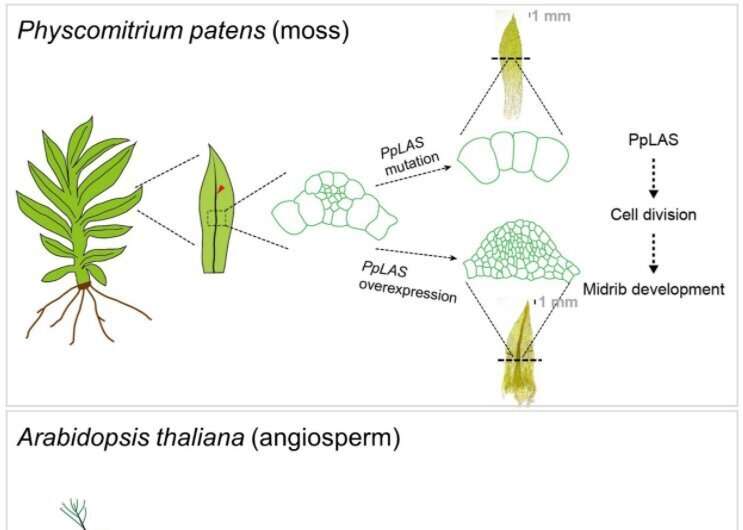Shared conserved module found in formation of moss midribs and seed plant axillary meristems

Plant landing is a major event during evolution. Accompanying their movement from aquatic to terrestrial habitats, different evolutionary plant lineages have evolved distinct characteristic body plans and anatomical structures, which have conferred on plants the adaptive ability to explore new environments.
Midribs are multi-stratose structures in leaves of certain mosses and are responsible for water conduction, as a beneficial supplement to surface capillarity, while axillary meristems (AMs) of seed plants can form lateral branches as secondary growth axes in lieu of the terminal branch, which has greatly altered plant architecture and affected fruit or seed production.
A research team from the University of Chinese Academy of Sciences (UCAS) and the Institute of Genetics and Developmental Biology of CAS has uncovered a molecular module shared between these two completely different anatomical structures.
In their study, Dr. Wang Ying and her colleagues revealed the mechanism underlying the organogenetic power of the Lateral Suppressor gene in Arabidopsis and its orthologous genes in Physcomitrium patens.
Combining molecular genetics, confocal imaging, and high-throughput transcriptome profiling to follow the formation processes of the two structures at cellular resolution, the researchers demonstrated that GRAS family genes promote the formation of non-homologous organs, AM initiation in Arabidopsis thaliana, and midrib formation in Physcomitrium patens.
They further showed that promotion of cell division is a common theme in two highly divergent species. Cell division is greatly compromised in Arabidopsis mutants, which accounts for the AM formation defects.
Meanwhile, reduced cell division activity also leads to midrib formation defects in Physcomitrium mutant leaves, according to the researchers.
Their work provides a comparative analysis of cellular processes underlying the formation of non-homologous organs and highlights a cryptic connection between axillary meristem and water-conducting tissues in different lineages.
This study provides a striking example of a more universal mechanism associated with evolutionary innovation, i.e., a conserved regulatory module featuring cell division promotion has been co-opted during evolution and reutilized in divergent developmental programs.
The research was published in Science Advances.
More information: Yanhua Ge et al, A conserved module in the formation of moss midribs and seed plant axillary meristems, Science Advances (2022). DOI: 10.1126/sciadv.add7275
Journal information: Science Advances
Provided by Chinese Academy of Sciences





















